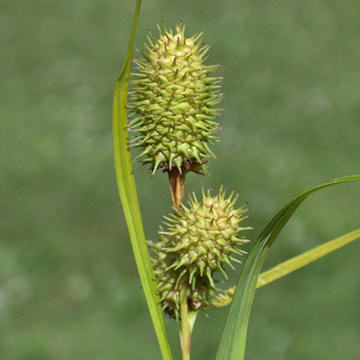

Carex squarrosa - (image 1 of 3)
Taxonomy
Family: Cyperaceae
Section Squarrosae
Habitat
Wet woodlands, ditches, stream banks.
Associates
Distribution
CT to NC, west to western Quebec, southeast MI, NE, and AR.
Morphology
Tufted perennial to 0.9 m; evergreen; aphyllopodic; leaves 3-6 mm wide; ligule much longer than wide; spikes 1-3, the lower third staminate, the pistillate portion elliptic, to 3 cm wide and 5.2 cm long, rounded at both ends; lateral spikes all pistillate if present, smaller, on erect short peduncles; bract of the terminal spike short and narrow; bracts of the lateral spikes elongate but not sheathing; staminate scales acute or acuminate; pistillate scales mostly concealed, acuminate or with short awns; perigynia numerous, squarrose-spreading, obconic to somewhat obovoid, inflated; body of the perigynium to 6 mm long, with 2 prominent ribs at the summit and a few obscure nerves; beak 2-3.5 mm, teeth 0.2 mm; achene slenderly ellipsoid-trigonous, 2.2-3 mm, about 2/5 as wide; style persistent with a strong bend beow.
Notes
Fruiting June to August
Wetland indicator: OBL
Carex typhina (Cattail Sedge) is similar but has an achene that is a bit narrower and a nearly straight style. Cattail Sedge also has somewhat wider leaves.
References
Curtis, L. 2006. Woodland Carex of the upper Midwest. Lake Villa, IL.
Gleason, Henry A. and A. Cronquist. 1991. Manual of Vascular Plants of
Northeastern United States and Adjacent Canada. Second Ed.
The New York Botanical Garden. Bronx, NY
Swink, F. and G. Wilhelm. 1994. Plants of the Chicago Region.
Indiana Academy of Science. The Morton Arboretum. Lisle, Illinois.
|
© Michael Hough 2009 |